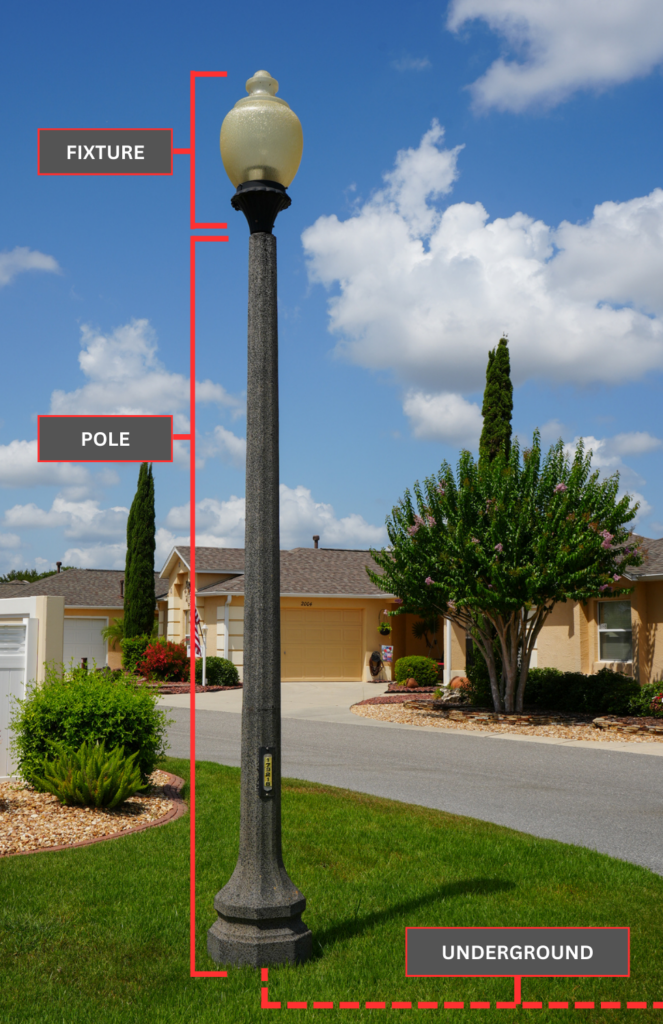Please review SECO Energy’s informational session on the October 2025 Lighting Services Pole Rate Adjustment below.
In communities across our service area, SECO owns the communal outdoor area lighting and provides valued services through agreements with “governing bodies” such as homeowners’ associations, community development districts, and municipalities. Not all homeowners live in planned communities with communal area lighting.
There are some misconceptions about what these area lighting components entail in terms of maintenance, servicing, and the associated fees. This page is intended to provide facts about the area lighting system and address questions about recent changes to logistics and fees.
As shown in the image below, area lighting systems are made up of three main sections: fixtures, poles, and underground components.
SECO Energy maintains and services all three sections of the area lighting systems. Services include repairing damage, replacing outdated parts, and storing necessary supplies to maintain the systems.

1. How was area lighting established in my community?
A clear explanation of how neighborhood area lighting evolved is necessary for establishing the proper context for a fair discussion around this topic. It basically works as follows:
Developer:
Developers design planned communities. During the design phase, their team determines the placement of streets, homes, walking paths, and other amenities – including lighting – in accordance with city, county, and state regulations.
Initially, your community developer chose SECO Energy to maintain your neighborhood area lighting and paid SECO Energy fees associated with this service.
HOA/Community District/Municipal Entity:
Once your community was established, the developer transferred the lighting service account to the entity charged with managing the fiscal affairs of your neighborhood. This governing body is likely either a homeowners’ association (HOA), a Community District, or other municipal entity.
Your community governing body is responsible for paying the monthly billing for area lighting service from SECO Energy. The community governing body determines how it will pass on these fees to homeowners within the neighborhood boundaries.
Members – Individual SECO Energy account holders:
For members who live in an area governed by an HOA, Community District, or Municipal Entity, costs for community services – such as area lighting – are passed to these homeowners. Your governing body determines how the fees are charged and passed to neighborhood residents. SECO Energy does not determine how the fees are passed to individual residents within your communities.
2. How did we get here?
Over the years, the costs associated with maintaining SECO’s area lighting system have increased drastically. However, the fees charged for this service have not kept pace. A recent lighting cost-of-service study conducted in early 2024 revealed that SECO’s fees charged to HOAs recover only a small percentage of the actual cost associated with providing neighborhood area lighting services.
This multimillion-dollar deficit grows as more neighborhoods call on SECO to maintain their neighborhood lighting service. Over the last five (5) years, SECO added more than 9,000 area lighting structures to our system. With our region’s rapid growth of residential neighborhoods, we anticipate this trend to continue and possibly accelerate. To prevent other SECO members who do not receive neighborhood lighting service from paying this fast-growing deficit, a rate adjustment to the neighborhood area lighting class of service became necessary. Some key factors influencing the adjustment include:
-
-
- Rising Maintenance Costs (labor, tools, transportation, warehousing, and equipment)
- Rapid growth/Supply Chain shortages
- Mandated LED Integration
- Interest Rates
- Aging Infrastructure/Inflated replacement material cost
- Property taxes
-
We remain committed to working with residential and commercial developers to provide high-quality lighting solutions that align with their design standards while ensuring these assets’ ongoing maintenance and servicing.
3. Are there alternative options for my community?
While many HOA boards impacted by the increase are contemplating how to pass the additional costs along to their residents, others are exploring alternative options for their lighting systems, including buyout or disconnection options. SECO plans to respect and support any alternative option taken for future lighting services.
We have options for HOAs to consider:
Three Options
Buyout option: Communities may consider purchasing the lighting systems and accepting responsibility for area light repairs and maintenance. In doing so, SECO will meter kilowatt-hour consumption. This process requires multiple steps:
-
- Your HOA must send a formal request for the buyout on an official HOA letterhead.
- The request should include the following information:
-
-
- SECO Billing Account #
- Number of poles/lights
- Pole Numbers – GIS #s
- Your specific request and explanation, along with the signature of an HOA board member
-
-
Please email your formal request to keyaccounts@secoenergy.com
Disconnection: If your HOA community is considering disconnecting the streetlights, please follow these steps:
-
-
-
- Call in to request a disconnect of the lighting service.
- Inform your HOA members about the planned disconnection. This will help prevent any confusion and avoid unnecessary calls regarding a reported area light outage.
- Ensure you have proper authorization to proceed.
- Have your SECO Energy billing account # and Fed ID# ready.
-
-
To Reconnect:
Please note that there will be a fee of $45 per pole if you choose to reconnect. Please note that lighting inventories are very limited. SECO reserves the right to use retired inventory, causing lights previously available for a community to potentially be used elsewhere on SECO’s system.
Lighting system removal:
-
-
-
-
- SECO Energy will work with the requesting entity to remove poles and fixtures.
- The specific details of the steps that must be taken will be handled on a case-by-case basis. They will depend on the alternative options being considered for future lighting.
-
-
-
4. Is the kWh price of energy I use in my home increasing on October 1, 2024?
No, the kilowatt-hour (kWh) price of energy in your home has not increased due to the rate adjustment for area lighting fixtures and poles. For most of the area lighting fee adjustments, the costs are typically billed to HOAs, governing bodies, and municipal organizations.
However, SECO Energy announced a kWh rate increase of approximately 9.17% for residential accounts that will take effect on May 1, 2025.
5. What is a Cost-of-Service Study?
A cost-of-service study is an in-depth analysis that determines the actual costs of providing specific services, in this case, area lighting. The study ensures SECO’s fees reflect the true cost of service, promoting fairness and equity among members.
6. How will I be affected?
SECO does not determine how the affected HOAs, municipalities, and community development districts will pass through the increase. However, you will likely see a change in your HOA dues or community maintenance fee.
According to our original calculations, we estimate the average monthly fee increase charged to individual residents to be approximately an additional $5 – depending on the type of fixtures within your community and the number of residents receiving the lighting service. (Additional Fee per Resident = Total Annual Increase charged to the HOA, divided by Homes Being Served, divided by 12 months).
7. Why can’t it stay the way it is?
SECO is a member-owned, not-for-profit utility. This means that our consumers are all SECO Energy members. We have a responsibility to all members to operate the utility as efficiently and as equitably as possible.
8. What are you doing to help?
In early 2024, SECO engaged an external firm to conduct a cost-of-service study on its lighting service fees. The study revealed that the cost of providing lighting services had outpaced the associated charges.
In May 2024, SECO Energy’s Board of Trustees and the Florida Public Service Commission (FPSC) approved an increase in the lighting service fees. SECO subsequently notified your governing HOA board of the fee adjustment. Following this notification, your HOA board reached out to SECO to express concerns about the significant increase in lighting service fees. SECO Energy also informed the membership in our May 2024 SECO News publication.
In response, SECO Energy’s Board of Trustees approved a re-submission to the FPSC, proposing a phased, two-year implementation of the fee increase. Upon FPSC approval, the first adjustment took effect in October 2024, with the final adjustment scheduled for October 2025, pending further approval and adoption. Additionally, SECO’s board directed staff to include another lighting cost of service study to accurately determine the amount of the October 2025 lighting adjustment.
This phased approach provides affected members, particularly HOAs, with additional time to make necessary budget adjustments while ensuring the continued maintenance and reliability of the area lighting system.
9. Where are we now?
In October 2024, we reduced the impact of the full cost of area lighting services by spreading expenses over a two-year period, pending further approval and adoption. This approach allowed members affected by the lighting increase additional time to make necessary budgetary adjustments.
After announcing the original increase in spring 2024, the Board and staff implemented a phased approach, applying half of the projected increase in October 2024 and planning the remaining adjustment for October 2025. However, through an updated cost analysis and key operational modifications, the second half of the increase has been significantly reduced.
Key Operational Modifications include:
-
- Outage Response: Adjusted from a very aggressive 24-hour response time to a 7– 30-day timeframe, which is more in line with industry standards.
- Outage Identification: Members and residents will now be responsible for reporting outages, replacing the previous practice of multiple annual system patrols performed by SECO personnel, sometimes resulting in overtime costs.
- Fiberglass Pole Replacements: Reducing capital outlay by transitioning from systemwide changeouts to an ‘as-needed’ replacement approach.
- Fixture Offerings: Reducing inventory carrying costs by shifting from a broad range of fixture offerings for new requests to a limited selection.
As we have mentioned in recent months, there are potential grants that may help offset some of our costs. However, due to an executive order issued by the new White House administration, many of our grant applications are currently on hold. In the coming months, we expect to have an update regarding the status of these grants and our ability to offset some of the cost of our resiliency and hardening infrastructure plans, including the future cost of modernizing and maintaining our lighting program.
10. What will happen with the LED transition? Will that cost be included in this increase?
Due to federal regulations, we have begun converting our lighting system from high-pressure Sodium (HPS) to LED lighting. Generally, historical and projected future costs are used to determine rates/fees. In response to the federal mandate to transition to LED lighting and the discontinuation of HPS light manufacturing, SECO factored in the anticipated upfront costs of LED lighting, along with energy consumption and maintenance costs, to accurately assess the cost of service and establish new area lighting fees.
The U.S. Department of Energy has published several reports on highlighting the efficiency and longevity of LED lighting.
We are dedicated to exploring all innovative resources and tools in order to meet the challenging price increase. We remain committed to delivering the best value and appreciate your understanding as we deal with this very sensitive issue.
Updated April 2025


